Advertisement
If you have a new account but are having problems posting or verifying your account, please email us on hello@boards.ie for help. Thanks :)
Hello all! Please ensure that you are posting a new thread or question in the appropriate forum. The Feedback forum is overwhelmed with questions that are having to be moved elsewhere. If you need help to verify your account contact hello@boards.ie
Base to Race training structure-the idealist manual
Options
-
10-08-2019 4:28pm#1It's lashing rain and I'm bored off my head so I thought I'd write a bit here on training structure to help people out from what I've learned over the years and to help me put my thoughts in Order as well. I mainly want to talk about periodisation as it is in my opinion the most important aspect of training and also the non-existent aspect in most amateur runners training. I'm no expert but this stuff is all borrowed from the greatest coaches to ever live and every successful coach from the 1960's on has used this overall training structure. It was so revolutionary that the marathon world record plummeted 8 minutes in 20 years!!!
The reason I'm writing this is due to the misuse of some of the terms I see on forums everywhere when it comes to things like Base and to try redirect the idea that very slow running is the ideal in every scenario, it's not but it's still very important for recovery and low level aerobic stimulus. A lot of books in general annoy me because of their one dimensional approach to training like Jason Fitzgeralds "80/20", not because they aren't well written and informative but because they focus so heavily on certain rules that they don't really show that training is malleable and that stress dictates training more than numbers or rules, they are almost overtly black and white.
So, If I'm going to start anywhere...It has to be with the godfather of modern training named Arthur Lydiard. Lydiard was a New Zealander who experimented on himself to find the best methods at first. This ranged from hard low volume training to running up to 280 miles per week. He is the man responsible for creating the basic training structure that has been behind 99% of every Olympic gold and World Record in every mid to long distance race since the 1960's. He also coached everyone from Joe Bloggs down the street to cardiac bypass patients using these methods. He is the most important coach in history and his approach is relevant to everyone, not just freak athletes.
Arthur Lydiard training
Lydiard eventually settled as a high mileage proponent, this was the same whether you were an 800m runner or marathon runner. His most famous 800m athlete was Peter Snell who would long runs on hills of 22 miles with the marathoners during base but I'll get back to that a bit later.
What Lydiard is most famous for is periodisation, A fancy way of saying phases of training leading up to a race. This is a periodisation table of Lydiard: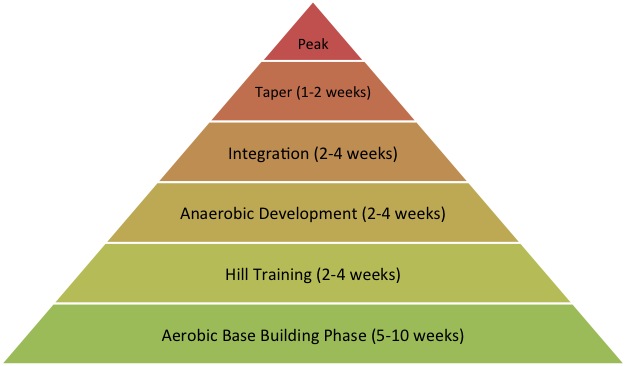
See, certain phases for certain lengths progressing from one to the next up to a race(that's what periodisation is)
Base
Base training is unequivocally the most important phase of training in Lydiards opinion yet you will rarely ever see amateur runners do it or misconstrue what a base phase is. A base phase is where your engine is built; As an old coach of mine who has a 48 minute 10 mile PB used to say to me "without the base, you are just a wet and empty sack pissing about". The reason a big strong base is important before you do anaerobic training(intervals etc) is because the stronger you are aerobically, the more punishment you can take and faster you can recover from harder workouts in the following phases.
Where people misconstrue base training from what I see is that you will often see people referring to building a base while doing hard intervals, this isn't base building. Base building is an aerobic phase with no specific race intervals.
The other side of the coin is that people think base is just easy running, that really shouldn't be the case either. Easy running is perfect when you are running hard interval sessions coming up to a race and need to recover while also gently keeping your endurance up but there's no intervals in a base phase so the need for true easy running is diminished. What Lydiard prescribed was a lot of marathon paced runs and slighly slower steady runs during this phase and a lot of volume too. If the stress of intervals is absent, it means you can run harder most days and accelerate aerobic improvements.
The base phase is also where your volume should be at it's highest because the intensity is low and you want to build that big engine. Most people get this backwards and their highest mileage is hit in the last few weeks leading up to a race when the intensity is also at it's highest(looking for injury and overtraining). Its like being able to walk 10 miles and trying to run 15 doing it this way, it's not logical. Lydiard and every other coach worth their salt would have peak mileage reached at the end of the base phase nearly 3 months before race day and the mileage gets cut down as intensity is added in the form of intervals and hard workouts. A guy doing 80mpw in Base, would only run 60 when training gets specific with intervals.
Hill phase:
I won't write much here as he kind of phased out this stage of training as he got older and it's based around hard to find drills and would probably injure most modern runners. The idea behind this phase though is to build strength and power through hills circuits to transition between that big base and adding race specific speedwork and to build a frame on that foundation.
Anaerobic phase
This will be the type of training most are familiar with here. Lung busting, leg sapping interval workouts that are race specific with easy runs in between. Base is foundation, this is how you peak. The idea of the anaerobic phase and doing interval workouts is to get fast but temporary gains. They get you sharp but like any peak, there's a drop at the other side. A lot of people do these year round but that shouldn't be the case as your body can only take this intense form of training for so long before it takes it's toll. Pretty much every top coach will limit this to 6-8 weeks as you it can fry your body and lead to overtraining if you constantly do these.
Lydiard would have his runners do a lot of interval workouts and time-trials at below race effort in this phase each week as they were strong enough from the mega mileage but that's not really the most relevant point 're periodisation. The length of the phase is. Bar taper, this phase has the lowest total weekly mileage of a training block because the intensity is very high.
Integration:
This is just a fancy way of saying of saying pure speed, the idea is improve your running economy so that the pace on race day will feel easier. People kind of do this already with strides leading up to race day but this is more idealists guide. Lydiard would have his athletes do workouts like sprints, 100's and 200's fast but with the focus more on speed than lung busting strength. Good recoveries and good form are most important here.
Taper
This is more personal and training block dependent I feel. I don't think there's a reason to have a cut and dried length to this and your body will probably tell you when it's time from experience. To refer than usual, a longer taper might work and some people will run better off a shorter taper. Generally, the more aerobically fit you are, the shorter a taper needed.
I hope this doesn't come off as preachy, I just think it's so important and doesn't get enough attention as this is literally the most revolutionary training concept of the last century, I don't think I should've called it the Idealist guide either as I think it should be the first thing people try to emulate and is much more important than getting frisky and clever with workout designs. Coaches have improved on the structure of the phases since Lydiard created this and have taken different approaches to it but the main ingredient of structure is still in the DNA of it and Lydiard is a good place to start as it's a more simplistic version than more modern day Canova type periodisation.
I also apologise to any pedantic type Lydirites who may happen across this and have a bone to pick with something, this is more a exceprt on periodisation than perfect Lydiard. One thing I will say is that if anyone takes home the message of the importance of the overall structure of the phases and what they are and implements them, I guarantee they will improve a sh!toad. I might write a bit more on different and more modern approaches if there's interest and I'm bored enough. Feel free to add, discuss or rip apart if you wish.32
Comments
-
Thanks for doing this. It's a very interesting read. For the different phases is it that the emphasis changes for two sessions a week and the rest of the running is easy?0
-
Interesting read, I have read similar approaches to base building. I wonder how this could be incorporated into the standard club training schule?0
-
Thanks for doing this. It's a very interesting read. For the different phases is it that the emphasis changes for two sessions a week and the rest of the running is easy?
It depends on what way you want to do it and different coaches will have different ideas. I won't say what I believe is best because it's going to be full of my own bias but I think staying true to the tags on each phase is more important than what exactly happens in them as that will be a more invidividual touch. Some coaches like Lydiard will say that easy running isn't a part of base and that the phase should be almost completely high-end aerobic(faster than easy but no faster than marathon pace) as the idea is to maximise aerobic gains as quickly as possible. If you look at the schedules in his books for base:
Monday: 1 hour @1/2 effort
Tuesday: 1.5 hours @1/4 effort
Wednesday: 1 hour @1/2 effort
Thursday: 1.5 – 2hours @1/4 effort
Friday: 1 hour @3/4 effort
Saturday: 2 hours or more @1/4 effort
Sunday: 1 – 1.5 hours @1/4 effort
The effort scale might be confusing to many but from reading a lot from Nobby and HRE over the years, 1/4 effort is faster than easy and 3/4 effort is around marathon effort and 1/2 lies in the middle. This was the main schedule used as a vehicle to show his methods rather than copy and run exactly like this schedule. He said that if you wanted to do easy running, you do it in the morning as additional mileage and long as it doesn't interfere with the main schedule above. So in Lydiards eyes, the emphasis everyday was on faster than easy paces during base. During anaerobic phases, easy days were used as part of the training schedule between workouts like many people do already. Believe it or not but that above base schedule was almost identical for Lydiard athletes whether they were 800m runners or Marathon runners, he believed that every runner needed a Marathoners base of endurance no matter what distance they ran bar sprinters obviously.
/un-Lydiard/ whether it's one, two or three or four workouts and the rest easy days, That's personal taste in my opinion. There's no reason why you can't have 7 days of high-end aerobic in base like Lydiard above and then only two workouts in anaerobic(race specific intervals). Whatever you feel comfortable with for your level or experience, the more important message is how important the phases are the progression of them as a whole, you can fiddle around with the details inside to suit you I think once the overall outline of the picture is there. Lydiard himself didn't even care what workouts were run in the anaerobic phase whether it was 6x800 or 4x1000 as long as you were producing lactate, more modern coaches have got more specific in that regard though. The first and most important part to get down is this in my opinion:
How beneficial the phases are(Each phase lays the groundwork for the next)
The severly underappreciated importance of base training
Overall structure and outline of good training
When intensity is low/volume should be high
When intensity is high/volume should be lower
These are the keys in my opinion. Very often, people start their self-coaching or learning by looking at singular workout design which is backwards in my opinion, I think it makes it much easier to understand training When you start working with the big picture first, then stand closer as your understanding grows until eventually getting out the microscope and looking at the tiny details like recovery times and fancy workout designs. 95% of the success in training is in the big picture of training outline and progression, the fancy workout tuning is a finishing touch. That's probably the main point I'm trying to drive home here.0 -
Thanks for taking the time to post this a up. Very informative!0
-
Really interesting post. Thank you.0
-
Advertisement
-
How beneficial the phases are(Each phase lays the groundwork for the next)
The severly underappreciated importance of base training
Overall structure and outline of good training
When intensity is low/volume should be high
When intensity is high/volume should be lower
This is actually ridiculously obvious when you spell it out like that
Thanks for taking the time to post this Fusitive, fantastic information.0 -
Interesting stuff alright and I'm sure I'm one of many who reads this and thinks......$hite, I'm doing something wrong!!
The one thing I wonder about is this re base training -What Lydiard prescribed was a lot of marathon paced runs
I find it a bit hard to believe that Kipchoge is doing mostly 2.55/km paced runs in his base training. I dunno. Maybe he is!0 -
Interesting stuff alright and I'm sure I'm one of many who reads this and thinks......$hite, I'm doing something wrong!!
The one thing I wonder about is this re base training -What Lydiard prescribed was a lot of marathon paced runs
I find it a bit hard to believe that Kipchoge is doing mostly 2.55/km paced runs in his base training. I dunno. Maybe he is!
I don't know about Kipchoge but I've read elsewhere also that marathon pace shouldn't be ignored even by the non-marathoner...
I did an LT test earlier this year and the coach gave me a training zone for easy runs which ended up being a bit too hot for me for easy runs but i noticed that for the few weeks i was trying it out my Garmin was my best friend giving me a new VO2 max after every run (well maybe not quite every run but i jumped up quite a few points in a relatively short space of time). In hindsight the pace i was running at in the HR zone corresponded to MP pace or slightly slower and i think, in light of the information above, that it probably is a good effort/pace to make aerobic gains and something i'll look at introducing again during a base phase. A base phase is possibly an ideal time for training by HR?
The description of base phase above has really resonated with me, i definitely had a different interpretation of it, and am now far more likely to commit to it in the (near) future with a better understanding of it.0 -
I suppose one of the problems is that many of us structure schedules around generic race plans that ASSUME the base is there - P&D, Hanson, JD, Fitzgerald etc. are all to varying degrees Lydiard influenced, and all have periodisation (sometime called ‘phases’) built in, but the base phase is often ignored or downplayed. As a result many people jump into these schedules without the prerequisite base, and struggle as a result - the plan just feels ‘too hard’ because you’re coming to it underprepared and underdeveloped. The Daniels Running Formula book (for example) does talk about structuring an entire season, but how many of us pay attention to those details?
Running clubs tend to be built around regular track or other sessions but neither of the clubs I’ve been with have been particularly effective at enshrining a holistic approach to the running year - sure, cross country is encouraged in winter, there’s a sniff of track in summer, and road racing tends to rule all year round, with many runners going from one to another (except track, hardly anyone does that) without any real sense of design or focus. (But not everyone - there are always a few knowledgeable sages that are as ignored as they are revered.)
The question above about how running clubs might build periodisation into the schedule is really pertinent. Obviously this is done at the elite level with one on one or small group coaching, but most of the membership showing up for the weekly sessions are probably treated to the same kind of thing all year round with little or no meaningful personal guidance - understandable of course, given the general scarcity of qualified coaching volunteers at some (most?) clubs.
Another thing - the ‘generic’ plans mentioned above would be periodised - what differentiates them is the structure of the individual periods or phases. Fitzgerald’s 80/20 methods, for example, are all about the ratio of moderate/high intensity, and the progression of same through different phases, in the ‘20’ part (not the ‘80’ part, which is more or less common to most contemporary approaches).0 -
Interesting stuff alright and I'm sure I'm one of many who reads this and thinks......$hite, I'm doing something wrong!!
The one thing I wonder about is this re base training -What Lydiard prescribed was a lot of marathon paced runs
I find it a bit hard to believe that Kipchoge is doing mostly 2.55/km paced runs in his base training. I dunno. Maybe he is!
Sorry, I was away for the last few days so didn't get a chance to respond. The problem here is that the quote is only half of the s sentence written. This was the full sentence:
"What Lydiard prescribed was a lot of marathon paced runs and slighly slower steady runs during this phase and a lot of volume too."
A better way to put this would be a lot of high-end aerobic running. If you read my second post above with an example Lydiard base schedule and explanations of the effort scale, you will see that only one run was at marathon pace per week( the 3/4 effort) but they were not hanging around on the rest of the week either and were running faster than easy everyday. Modern day Kenyans like Kipchoge actually run A TON of high-end aerobic runs but they use a more modern and much more complex form of periodisation.
Lydiard uses what is called linear periodisation-i.e one phase is solely responsible for one type of training- base is for purely aerobic
Modern day Kenyan is called funnel periodisation- I.e base is a time to focus on Aerobic base and pure speed base ala sprinting. The idea here is that you need both a foundation of aerobic and base speed to build yourself up to handling and getting more benefits from your specific training. Think Lydiard base+integration phase happening in the same phase before hills or anaerobic phases. This would be what Magness has in his plans if people want an example that's easy to come by or Canova if you want to read 100's of pages.
That's much more complex and probably not something to deal with right now.0 -
Advertisement
-
I'm bored again and this might distract me from the temptation to hit the pub so I thought I might add onto this post and venture into the slightly more complex world of funnel periodisation, this is going to be confusing but the more time you spend thinking about it, the clearer it will become, I have'nt fully come to terms with an absolute understanding of all this either beyond the general ideas so anyone who wants to chip in would be more than welcome. I'll use Magness as there is a wealth of info out there on his training and he's got a few handy powerpoint presentations too from here for 5k training:(his books would obviously be the best source but this helps break down the key points for a place like this)
https://www.slideshare.net/sjm1368/evolution-of-training
Magness Periodisation: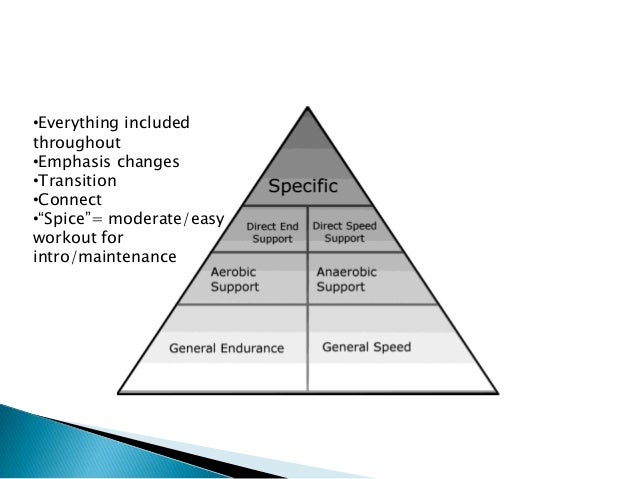
As you can see straight away when compared to the OP periodisation table, there is a clear difference straight away, two things are going on in each phase
Base:
You have general endurance(aerobic conditioning) and General speed(sprinting). This approach to base is pretty modern and would be what you would nearly every world class runner do these days. The general idea of this phase is to once again be high volume/low--->moderate intensity as the Lydiard schedule does too, peak mileage of the whole training schedule is reached in the last week of base(in Magness case, that is 12-13 weeks before race day). Here is Magness aproach to general endurance side of the base phase: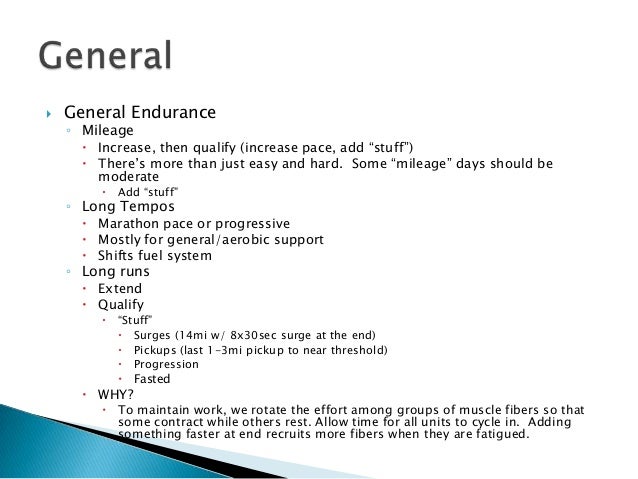
The general aerobic base is built through total mileage, long aerobic tempos and long runs early in the plan
Mileage:
Build mileage first and add then add intensity second as you become stronger
Tempos:
Progressive(fast twitch) or steady pace runs(slowtwitch) first from marathon pace to steady pace(generally 40-60 mins in duration)
changing to short LT runs which get progressively longer as the base phase progresses(split tempos for Fast twitch i.e 2x12 mins w/1.30 min recovery)(steady pace LT for slowtwitch i.e 24 mins w/ no recovery) LT workouts never longer than 30 minutes)
Long run:
Increase volume and adding work like pickups or surges towards the end
Fasttwitch: shorter and less frequent long runs, with broken up pickups or surges, progressive suits better but lower volume and lower intensity suits better
Slowtwitch: Can handle longer and faster long runs, will see benefits from more sustained steady efforts
The general speed side consists of improving speed obviously mainly done through short sprints up to 200's. sample progression of speedwork during base: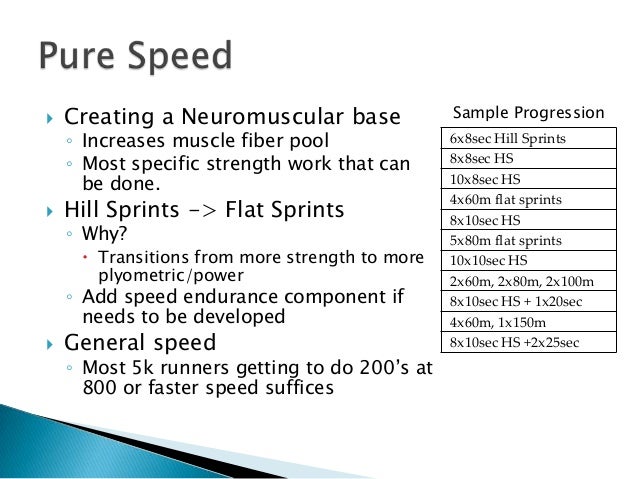
Now we have that covered, here's a sample plan of Magness base: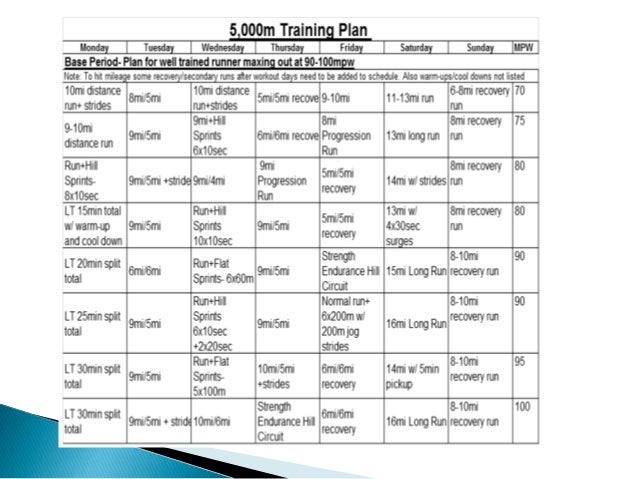
Obviously the mileage and intensity are much higher than most would be able to do in base. i.e someone who is only starting running for the very first time would be very low volume and maybe strides, someone who is in the middle would be medium volume would be able to have a slightly drawn back schedule in terms of intensity. But this is just a way to illustrate the ideas of training to people who mostly follow cookie cutter training plans. This is to illustrate how the elements above come together, Individualisation and thinking more deeply about training and the different ways to skin a cat.
As many here probably know, I have deeprooted hatred towards back of a book training plans, they serve their purpose but there is much better resources out there for people to learn from. I picked Magness here because he has a lot of writing and because he cherishes individualisation, one of if not the most important aspects of training. When many people pickup a book plan, they don't base their decision heavily on how it could suit them, they often base it on the success of others and that can be problematic, a fast twitch runner needs a completely different approach to training than a slowtwitch for instance, and many of the plans out there are heavily biased towards slowtwitch type runners and are very one dimensional in their approaches too.
I thought I'd finish this tonight but obviously not because I kind of wrote more than I thought:pac: but I'll hopefully write more on that tomorrow as well as finish off the other phases after base on Magness. I hope this doesn't come across as preachy and know it all like(I'm a long long way from knowing it all), I'm not trying to force my will on anyone, just trying to get more thought and approaches to training here so there's more options out there for anyone out there who is interested.0
Advertisement


